Ask a question from expert
Integrated Business Management Project Assignment
31 Pages7420 Words329 Views
Added on 2020-03-16
Integrated Business Management Project Assignment
Added on 2020-03-16
BookmarkShareRelated Documents
Running head: BILINGUAL EDUCATION1Integrated business management project Student Name: - Harmandeep kaur JawandaStudent id: -CCC3085Topic: - Bilingual education in schools
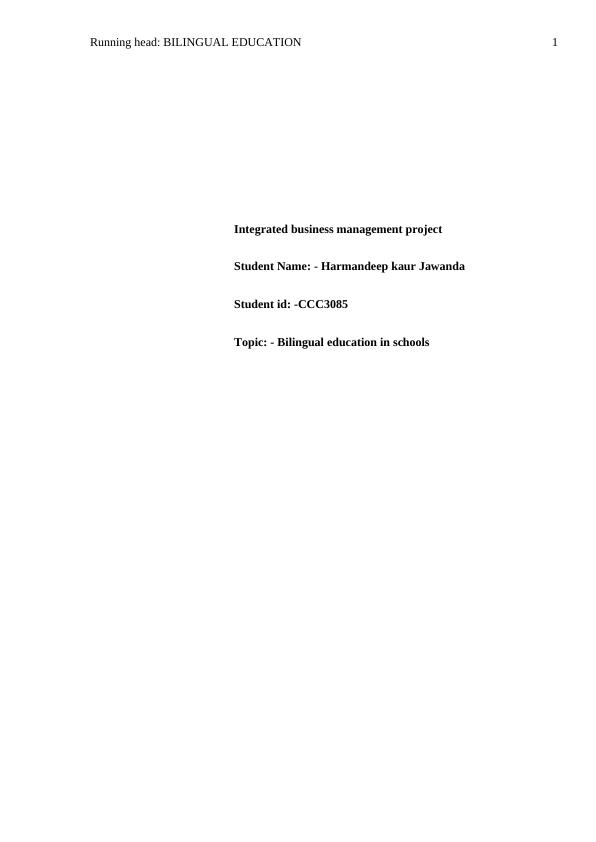
BILINGUAL EDUCATION 2Contents1.0 Introduction..............................................................................................................31.1 Aim and scope......................................................................................................32.0 Literature review......................................................................................................42.1 Infant or Child bilingualism.................................................................................42.2 Role of bilingualism in Australia.........................................................................52.3 Bilingual education at home.................................................................................62.5 Benefits of bilingual education............................................................................62.6 Challenges in Bilingual education.......................................................................82.6.1 Lack of bilingual teacher training.................................................................82.6.2 Lack of managerial support...........................................................................92.6.3 Failure to use language..................................................................................92.6.4 Low expectations........................................................................................102.6.5 Rules and regulations..................................................................................102.7 Recommendations..............................................................................................103.0 Final Report on Bilingual Education in Schools (colleges and universities).........113.1 Executive Summary...........................................................................................113.2 Objectives...........................................................................................................123.2.1 The specific objectives are:.........................................................................123.2.2 Research questions......................................................................................123.3 Scope and limitation of the report......................................................................133.4 Background information....................................................................................133.4.1 Research Design..........................................................................................133.4.2 Research Instruments..................................................................................143.4.3 Pilot Test.....................................................................................................14
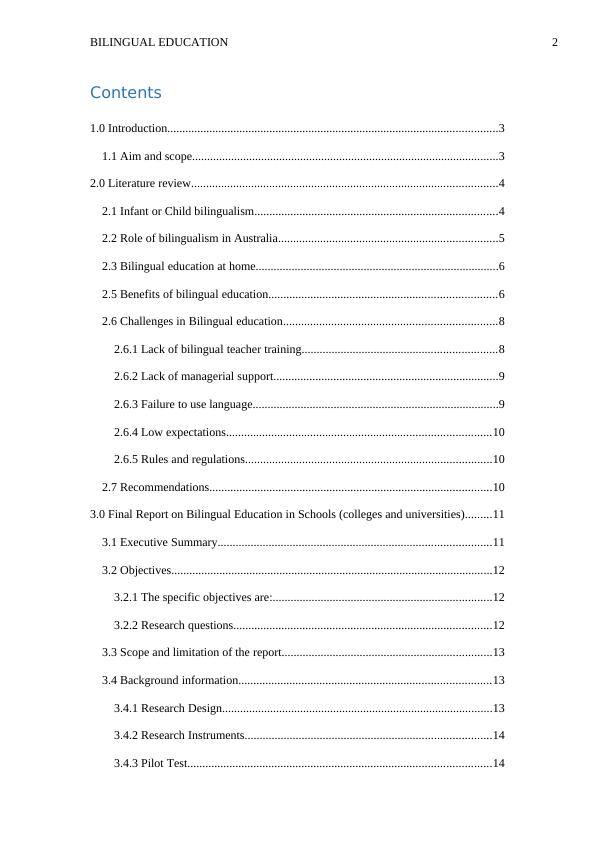
BILINGUAL EDUCATION 33.4.4 Reliability of the measuring instrument......................................................153.4.5 Data Collection Procedure..........................................................................153.4.6 Data Analysis and Presentation...................................................................153.5 Proposed operative suggestion...........................................................................153.5.1 Japanese in Australia...................................................................................163.5.2 Programs for improving bilingual education in the early childhood..........173.5.3 Importance of Bilingual Language Use......................................................193.5.4 Strategies to improve bilingual education language...................................21References....................................................................................................................23
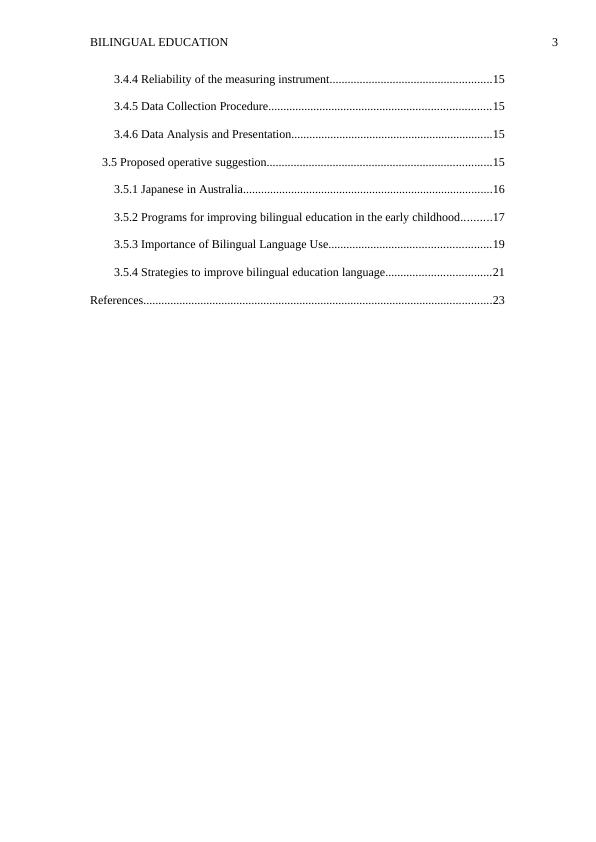
BILINGUAL EDUCATION 41.0 Introduction Changes in the Bilingual education have important influence on educationaround the world. This report provides some of the major research related to purposeand effectiveness of the bilingual education. Bilingual education includes the activepractices of learning based on two languages used by the educational institutions ofcountries in the society where various languages exist. It may be the situation wheretwo different languages exist. On the other hand, it may be the situation that ratherthan the state language, other languages are present. In present time, bilingualprograms is used in the colleges, schools and universities where they are payingattention on the study of the foreign language and international cultures. Along withthis, bilingual programs are meant to enhance student interaction in interculturalenvironment. Now, bilingual education can be found in the pre-school institutions.There is vast contribution to the bilingual education system at an early stage. Forinstance, popular and famous project ‘LIGHT’ is actively supported by manycountries i.e. France, Germany, Finland and Austria. It is perceived that bilingualeducation in the early stage is most effective for children as children are more open tothe new and they do not have any kind of obstruction and typecast. For instance, thereis one of the Australian school focusing on the bilingual education i.e. HuntingdalePrimary school. In this education system, school is providing different curriculum todevelop bilingual skills in the students (Pray & Jimenez, 2009). 1.1 Aim and scope The main objective of this report is to build and analyse issue of bilingual ineducation system across Australia and find out the most possible solution to deal withthis issue. It synthesizes and summarizes the appropriate empirical work on bilingual
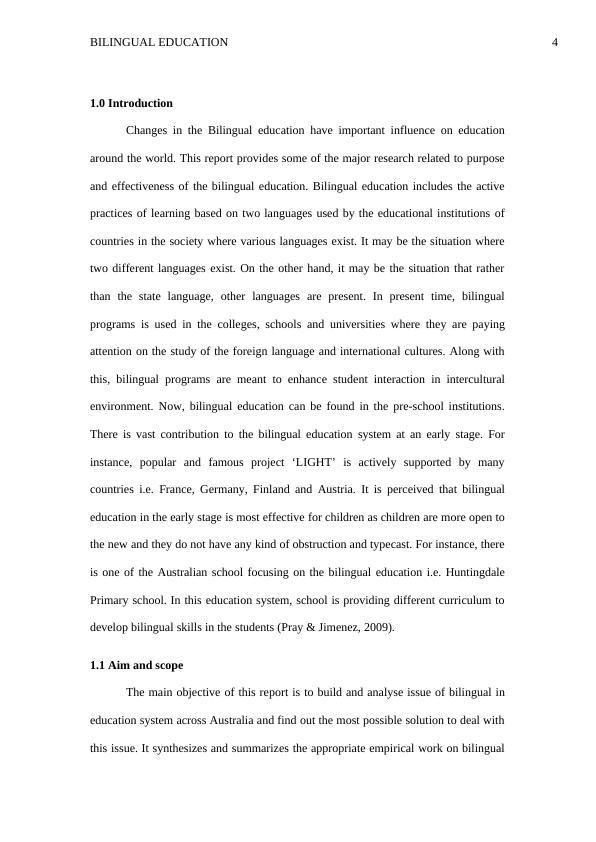
BILINGUAL EDUCATION 5education in schools at early stages. This report evaluates the quality of these studiesand focuses on the improvement if bilingual education system in the schools. Thedriving force for this research is to create the understandings of how immersionchildhood education contributes is beneficial in bilingualism and early schoolimprovements for success. For the research, recent relevant studies on the bilingualand immerse early childhood programs would be focused. 2.0 Literature review The term bilingualism is quite difficult and controversial to define. Accordingto Baker (1993), bilingualism is a kind of child who is able to speak two languagessmoothly. Some other researchers argued that bilingualism starts immediately thestudent is able to produce complete and meaningful speech in other languages.Further, bilingualism begins when someone starts to understand other languageswithout any barriers. In bilingualism, there is one more term i.e. infant or childbilingualism. According to the Saunders (1988), infant bilingual can be described asthe immediate acquirement of two languages from birth. Child bilingualism issuccessive fluency in two languages i.e. child learns first language within the familyand then learns second language in preschool or early school years. Those childrenwho are bilingual before four years of age have more chances of using the twolanguages fluently. Along with this, they have awareness of language; they have highlevel of level of adeptness at divergent thinking, creative thinking and conceptformation. There should be bilingual education system in the Australian schools as inthe country, majority of the Australian born households are not bilingual andimmigrant households. So, for the development of children, there must be bilingualeducation system in the schools (Lin & García, 2016).
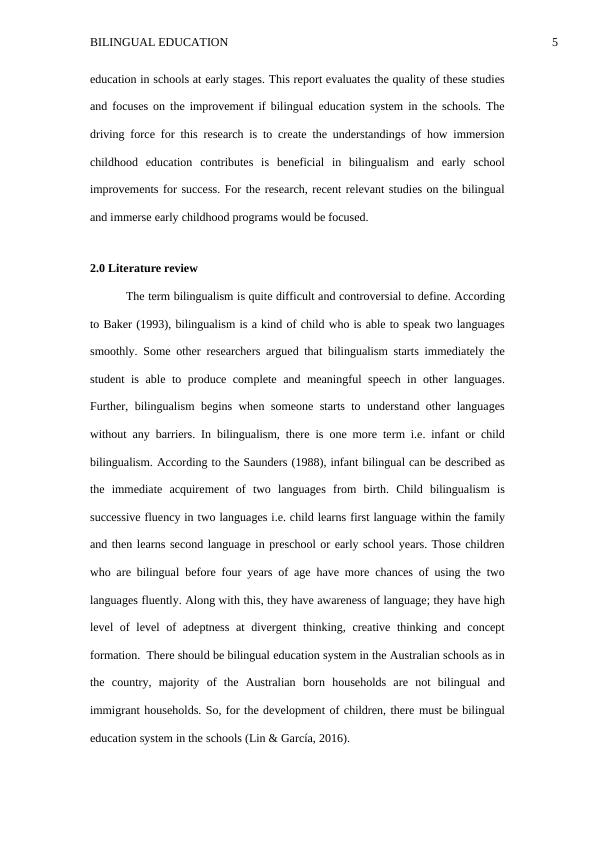
BILINGUAL EDUCATION 62.1 Infant or Child bilingualismChild bilingual is one who has successive fluency in two languages. Thosetypes of children acquire first language within the family and then learn secondlanguage in the school years. If a child has not get exposure of another language frombirth or within the family, then he or she will not be classified as an infant bilingual ashe or she is not learning those two languages by birth. In the Australia, there is themulticultural society and bilingual education is actively debated in the society.Bilingual education must be provided at childhood to enhance adoption. Park (2007)argued that foreign women who are working in the country must adopt language inwhich they can raise their children comfortably. According to her, proficiency in themother tongue is helpful in the development of children in terms of learning skills. The world is changing at the continuous level and there is the need of highlydeveloped skills for the students for becoming successful global citizen. There arevarious situations those are essential for the students to become successful. In theschools of Australia, teachers are teaching different ways of learning and thinking tothe students. Those skills can be transferred in the daily life and everyday situationsfor lifelong learning. It is crucial to understand the role of bilingual education in theAustralian society (Skerrett & Gunn, 2011). 2.2 Role of bilingualism in Australia At all the levels of education system i.e. advisors, educators, teachers,ministry, school management, boards of trustees, and classroom teachers, there mustbe an effective message of maximizing bilingual education for the children or infantswho speak only one language. The use of various languages affects bilingualeducation and education result for bilingual people. It is considered by the researchersthat combination of languages improves the skill base of a person. Bilingual
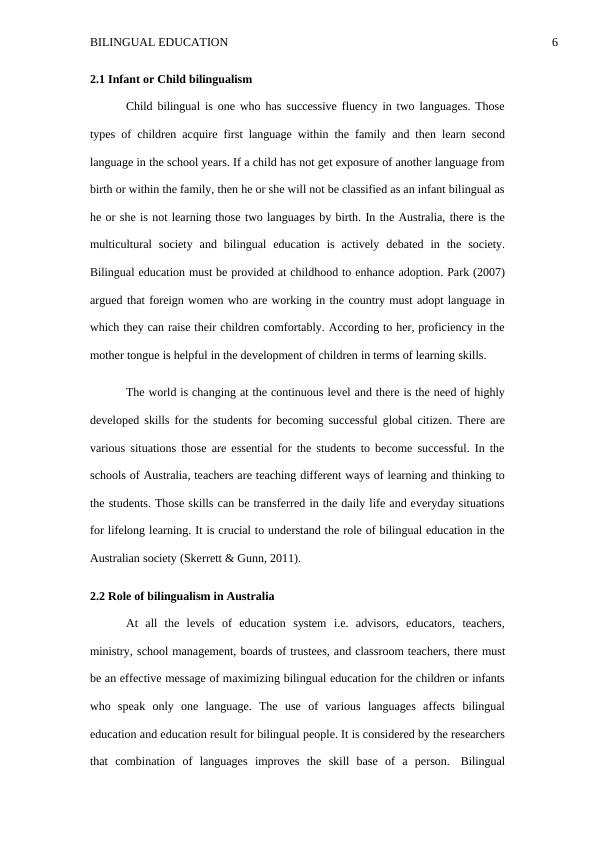
BILINGUAL EDUCATION 7education entails the practice of teaching children in their native language andsecondary language concurrently. There are many forms of bilingual educationbasically and the implementation of the program in the education system is veryeffective (Umansky & Reardon, 2015). Bilingual education has crucial role to providethe opportunities to the children to progress in their subjects including science,mathematics, and social studies in their native language. Along with this, they learnsecond language in the separate classrooms. The objective of bilingual education is tomake the student fluent in two different languages. Bilingual education system plays avery vital role in the world as common language is crucial for good communicationand understanding. Due to the multicultural societies and existence of variouslanguages in these societies, bilingual education has great importance. The role ofbilingual education will establish harmony and stillness among the people in thesociety (Mongeau, 2016). In Australia, many schools have bilingual programs for children and studentswho are speaking community languages other than English. These programs areconducted from the support of the government. There is bilingual education for nativestudents. For instance, in the Northern region, bilingual programs for the nativestudents were started in the early 1970s. Furthermore, the government of Northernregion announced to start 21 bilingual programs to teach English as the secondlanguage in 1998. Along with this, bilingual programs were continuing under thepretext of two-way education. After that, in 2005, The Minister of Education,Employment and Training announced for renewal bilingual education at 15community education centres. The aim of renewal was to provide effective educationfrom pre-school to every region.
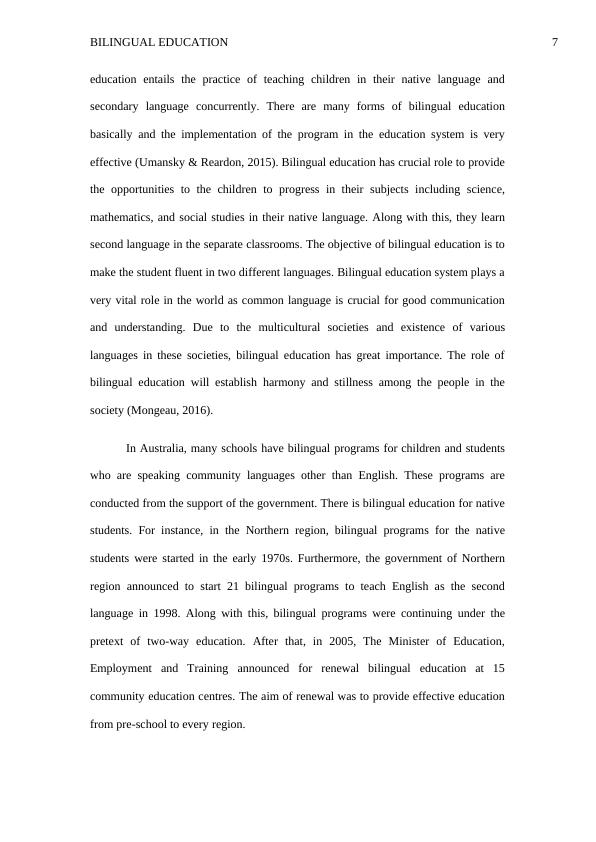
BILINGUAL EDUCATION 82.3 Bilingual education at homeUsing two languages in households is not an easy job. It needs lots ofdiscipline and patience from the parents. In Australia, there are around 5 millionpeople who uses other languages rather than English at home. The most possiblelanguages spoken by people include Italian (2%), Mandarin (2%), Greek (1%),Vietnams (1%) and Cantonese (1%) and Arabic (1%). If someone grew up in Francein a bilingual family in which father is French-speaking and mother is English-speaking, then there is the need to speak in their respective languages by the parentsas their children wants to benefit in each culture and communicate with others in thesociety (Department of Immigration and Border Protection, 2012). By using both thelanguages, child will get fluency in English as well as France language and willbecome bilingual. Raising a child with two languages needs continuous and sustainedefforts by the parents. But there are some families that may not follow bilingualsystem in the households. Some might have geographical rules within the house.Therefore, it is important to enhance the bilingual education system in schools so thatchildren can learn one language in home and another language in schools (Skutnabb-Kangas & McCarty, 2008). 2.4 Bilingual education at school-The child can easily learn new language starting from birth to approximately eyears old. From 2 to 3 years old, children know that language they can express andexpose themselves by tongue and most of the languages are introduced in the schools.In the bilingual programs, language is considered to be integrated into curriculum. Inthe schools, teachers teach something by the language. Being bilingual basicallymeans speaking two languages without necessarily learning them. There are some
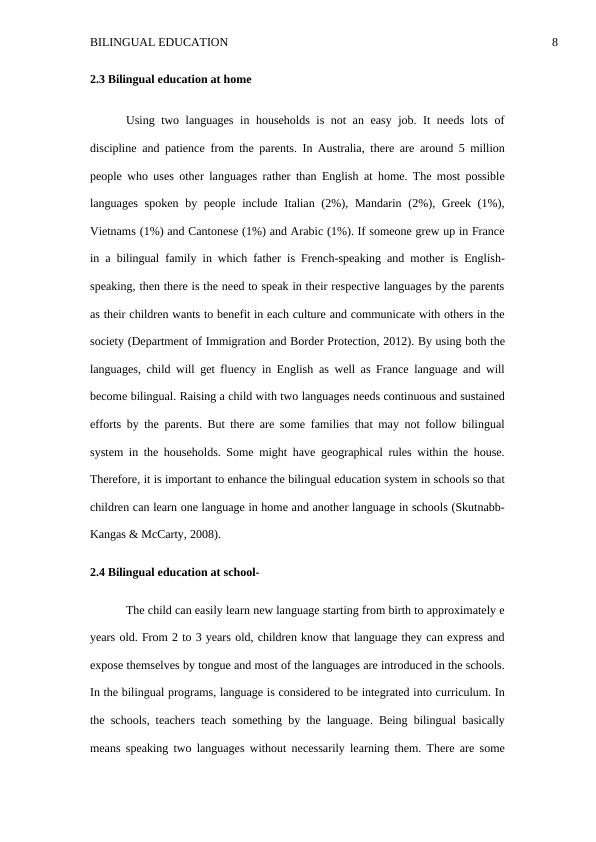
End of preview
Want to access all the pages? Upload your documents or become a member.
Related Documents
Report On Bilingual Educationlg...
|13
|3879
|53
Developing an Effective Quit Smoking Campaign in Australialg...
|21
|4518
|135
Comparison of EYFS and Montessori Curriculalg...
|15
|3953
|2
Business and management research -lg...
|32
|9520
|17
Early Childhood Education and Care: Case Study Analysislg...
|13
|3572
|54
Parental Involvement in Relation to Children Education – Cultural Differences on Choices of Out of School Activitieslg...
|19
|4364
|76